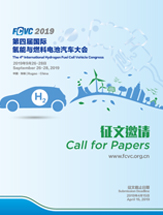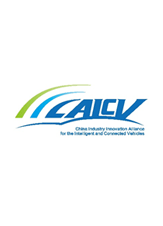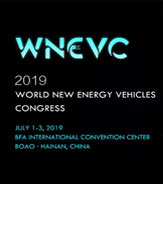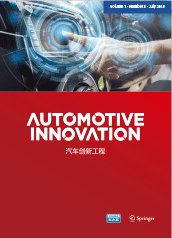

|
The journal Automotive Innovation is sponsored by China SAE, published through Springer, distributed around the world, and reflects the top-level research and technical advance of automotive engineering. Automotive Innovation newsletter in February includes the following contents: 1. A Glimpse of Experts——Prof. Dr. Ferit Küçükay from Technology University of Braunschweig, Germany 2. Article Recommendation——Four papers on technology of transmission of EV, engine, energy-saving and car body design 3. China SAE News: · Calling for papers on HMI technology and FCV is counting down, and deadline is April 15. · Annual Plan of China Industry Innovation Alliance for Intelligent and Connected Vehicles for 2019 was released(Plan for 2019 and work report in 2018 can be downloaded). · The World New Energy Vehicle Congress will be launched in China |

 Prof. Dr. Ferit Küçükay President of Automotive Engineering (IAE),Technology University of Braunschweig |
Research Interests Vehicle Dynamics, Chassis Engineering, Powertrain (especially hybrid- and electric drivetrains), Driver Assistance Systems and Automated Driving, etc. |
||
|
Achievements and Contributions He graduated from the Mechanical Engineering Department of the Technische Universität München, Germany and got his Ph.D. there in 1981. He was qualified with “Habilitation” (university lecturer) in mechanics and had worked for BMW for years. In 1997, he was invited to take over the Institute of Automotive Engineering (IAE) at the Technische Universität Braunschweig. He has written many influential books that are helpful to promote the development of the automotive technology. He is the author of the book “Dynamics of Transmission, Springer”, and the co-author of “The Book of Automotive Transmissions”, “The Electrification of Powertrain” and “Reference Book Electromobility”. Furthermore, he is the author or co-author of numerous publications and owner of several patents in the field of automotive engineering. |
|||
|
Part Time Jobs in Academic Organizations He is the Member of the Board of Directors “Automotive Research Centre of the Federal State Lower Saxony” (NFF) and the head of scientific board at the “TÜV Nord-Institute for Automotive Technology and Mobility”. He is chairman and member of scientific and steering committee of several international symposiums and magazines. He serves as consultant for the German Research Foundation (DFG), the German Institute for Standardization (DIN) and the German Federal Motor Vehicle Registration Agency. |

   
|
Design of a Hydraulic Control Unit for a Two-Speed Dedicated Electric Vehicle Transmission Xiangyang Xu, Wenbo Sun, Tianyuan Cai, Yanfang Liu, Xiao Han |
||
| Two-speed automatic transmission is one solution to increasing the economic efficiency and dynamic performance of battery electric vehicles (BEVs). The hydraulic control unit (HCU) is a key component in automatic transmissions, and directly determines the quality of shifting. In this paper, we propose a design for a 2DET hydraulic control unit based on the structural scheme and shift logic of a two-speed dedicated electric vehicle transmission (2DET) with two wet clutches. The system is composed of three subsystems: an oil pressure regulating and flow control system, a shift operation and control system and a cooling and lubrication system. The results of our experiments, including the valve body bench tests, transmission bench tests and vehicle test, show that our design for a hydraulic control unit meets the requirements. | |||
|
Keywords: Automotive industry · Automatic transmission · Battery electric vehicles · Hydraulic control unit Xu, X., Sun, W., Cai, T., et al.: Design of a Hydraulic Control Unit for a Two-Speed Dedicated Electric Vehicle Transmission. Automotive Innovation 1(4), 300-310(2018) |
|||
| Full Paper Reading>> | |||
   
|
Impacts of Vessel and Injected Water Temperatures on Direct Water Injection in Internal Combustion Rankine Cycle Engines Jingtao Wu, Zhe Kang, Zhehao Zhang, Zhilong Li, Jun Deng, Zhijun Wu |
||
| This study focused on the effects of vessel and injection temperatures on direct water injection in internal combustion Rankine cycle engines through experimental and numerical methods. First, a study was carried out with schlieren photography using a high-speed camera for simultaneous liquid-gas diagnoses. Water was directly injected into a constant-volume vessel that provided stable boundaries. We wrote a Matlab program to calculate spray tip penetration and cone angle from the images. For the further extension of boundary conditions, a numerical model was established and calibrated in AVL-FIRE for the thorough analysis of injection characteristics. Both experimental and numerical results indicated that injection and vessel temperatures have different effects on spray tip penetration. An increase in injected water temperature leads to shorter spray tip penetration, while the spray tip penetration increases with increasing vessel temperature. However, increased injection and vessel temperatures can both decrease the spray cone angle. Moreover, the simulation results also suggested that heat conduction is a main factor in boosting evaporation under top dead center conditions. When the internal energy of water parcels surges, these parcels evaporate immediately. These results are helpful and crucial for internal combustion engines equipped with direct water injection technology. | |||
|
Keywords: Internal combustion Rankine cycle · Direct water injection · Injected water temperature · Vessel temperature Wu, J., Kang, Z., Zhang, Z., et al.: Effects of Vessel and Water Temperatures on Direct Injection in Internal Combustion Rankine Cycle Engines. Automotive Innovation 1(4), 331-341(2018) |
|||
| Full Paper Reading>> | |||
   
|
Design of a Regenerative Auxiliary Power System for Service Vehicles Yanjun Huang, Milad Khazraee, Hong Wang, Soheil M. Fard, Tianjun Zhu, Amir Khajepour |
||
| This paper presents a RAPS, namely the regenerative auxiliary power system, for the vehicle with special accessory power systems. Taking city buses and delivery trucks as examples, service vehicles keep engines idling to power their auxiliary devices (e.g., refrigeration systems and hydraulic pumps). The potential fuel savings brought on by the electrification of these auxiliary systems are first quantitatively analyzed over a typical drive cycle for a delivery truck. The RAPS is then designed, and its components are sized in accordance with the objectives of compactness and cost-effectiveness. By introducing the proposed RAPS into a conventional delivery truck with an internal combustion engine, the powertrain can be treated as a hybrid because of adding an extra battery. As a result, to pursue a high overall efficiency, a holistic controller is presented for determining how and when to recharge the battery while minimizing the auxiliary system’s power consumption. More importantly, the proposed RAPS saves about 7% fuel when compared with consumption by conventional service vehicles. | |||
|
Keywords: Anti-idling · Component sizing · Auxiliary system electrification · Power management control Huang, Y., Khazeraee, M., Wang, H., et al.: Design of a Regenerative Auxiliary Power System for Service Vehicles. Automotive Innovation 1(1), 62-69(2018) |
|||
| Full Paper Reading>> | |||
   
|
A Two-Level Cross-Sectional Optimization Approach for Automotive Body Concept Design Huan Qin , Zijian Liu , Yu Liu , Haolong Zhong |
||
| Concept design is vital important in development of auto-body and it has great effects on later design work. In this paper, a two-level cross-sectional optimization approach is presented to shorten concept design cycles. First, an exact structural analysis approach for spatial semi-rigid framed structures, i.e., the transfer stiffness matrix method proposed in our previous study, is adopted for both static and dynamic analyses of body-in-white (BIW) structure. A two-level cross-sectional optimization approach is then proposed for an automotive BIW lightweight design, and genetic algorithm is used to solve the optimization models. Afterward, an object-oriented MATLAB toolbox, using distributed parallel computing techniques, is developed to promote the concept design of the BIW structure. Finally, relevant numerical examples demonstrate the validity and accuracy of the proposed method. | |||
|
Keywords: BIW structure · Concept design · TSMM · Cross-sectional optimization · MATLAB toolbox · Distributed parallel computing Qin, H., Liu, Z., Liu, Y., et al.: A Two-Level Cross-Sectional Optimization Approach for Automotive Body Concept Design. Automotive Innovation 1(2), 122-130(2018) |
|||
| Full Paper Reading>> | |||

 |
|||
| Calling for papers on HMI technology and FCV is counting down | |||
|
HMI design has become an important symbol of ICV innovation. and Automotive Innovation is calling for papers around the world on this special topic. Prof. Fang Chen, a professor of Chalmers University of Technology has been invited as the guest editor-in-chief of the special issue.
Automotive Innovation and FCVC2019 are jointly calling for papers on technology of fuel cell vehicles, and all experts and scholars from universities and research institutes around the world are welcome to submit papers. FCVC2019 will be held on September 26-28, 2019 in Rugao, China, and more than 2000 delegates will be expected. Deadline: April 15, 2019 Papers on FCV Submission: http://wwww.fcvc.org.cn/ Papers on HMI Submission: http://www.springer.com/42154/ |
|||
 |
|||
| CAICV Annual Plan for 2019 released | |||
|
In order to promote the development of China's intelligent and connected vehicles, China SAE
and CAAM, with the support of the Ministry of Industry and Information Technology(MIIT), established the "China Industry Innovation Alliance for Intelligent and Connected Vehicles " (CAICV) in 2017. The minister and the vice minister of MIIT serve as chair and vice-chair of the CAICV Steering Committee respectively.
So far, CAICV has six working groups: V2X, Cyber Security, New Vehicular High-speed Network, Automated Driving Map, Basic Data Platform and Commercial Vehicle.
CAICV has released its annual plan for 2019 on the researches of policy and strategic, key common technologies, standards and regulations, testing and demonstration, industrialization, academic exchanges and international cooperation, and personnel training.
CAICV Annual Plan for 2019 Download: http://www.caicv.org.cn/a2783.html CAICV Working Groups Work Report in 2018 Download: http://www.chinasaejournal.com.cn/a2803.html |
|||
 |
|||
| The World New Energy Vehicle Congress will be launched in China | |||
|
The World New Energy Vehicle Congress (WNEVC) will be launched on July 1-3 in Boao, Hainan China, focusing on the transformation and upgrading of the automotive industry and ecological environment improvement, and it will bring together global experts and industry elites to share their insights and discuss development trends and innovations of New Energy Vehicles (NEVs), such as technologies, industry ecosystem, government policies and business models. It also aims to build industry consensus, clarify growth direction, and identify effective pathway of integrated development of electrification, intelligence and shared mobility.
Highlights: · Over 1,200 global delegates are expected to attend it, including prominent government officials, well-known entrepreneurs, specialists and scholars as well as engineers and technology developers from the political, industrial, academic and research fields. · Top 10 Innovative Technology and Top 10 Advanced Technology Trend will be released during WNEVC. For more detailed information, please logo onto the website http://www.wnevc.org.cn/IndexEn.aspx. |

|
Automotive Innovation The first top English academic journal of China’s Automotive Industry ● Global subscription ● Reflecting the top-level research and technical advance of automotive engineering ● A good platform for demonstrating the technology innovation on automobiles Editors-in-Chief Jun Li, Academician of CAE, President of China SAE, Professor of Tsinghua University Frank Zhao, President (2018-2020) of FISITA, President of Tsinghua Automotive Strategy Research Institute Executive Editor-in-Chief Prof. Mike Ma,Executive Chief Editor of Automotive Innovation, Professor of Jilin University, VP Technical FISITA |
||||
|
Paper submission and browse www.ChinaSAEJournal.com.cn www.springer.com/42154 Contacts: Ms. Huisi, Gu Tel: +86-10-50950101 Email: ghs@sae-china.org |

|
|||
|
Sponsored |
Co-operated with
|
|||